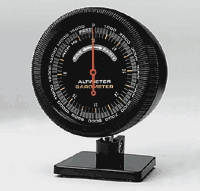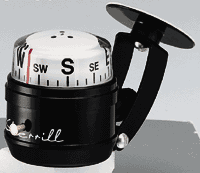
Recently a fellow discovered my post about flying on the cheap (Oct 2001) and got so excited he had to give me a call. Although he wasn't quite ready to begin building, my article convinced him to take the plunge. As his first step toward building an inexpensive flying machine he'd purchased the first of the instruments he planned to install in it.
A clock. One that cost nearly $200.
I stared at the telephone for a minute. The guy was still yammering away as I gently hung it up and went back to work. In terms of flying on the cheap, two hundred bucks is enough for a fuselage or a set of wings. Common sense is remarkably uncommon stuff in the world of aviation.
Flying on the Cheap means VFR-Day; the epitome of fair-weather flying. No IFR timed turns nor precision descents into the murk. And the odds are, you already own a perfectly good clock for that kind of flying. In fact, it's probably strapped to your wrist right now.
The same is true with regard to your altimeter. VFR-Day you can see the terrain. Your only need for an altimeter is to ensure vertical separation and avoid the bureaucratic wedding cakes and for that you don't need a precision instrument. A cheap 2" altimeter - - the kind from J.C.Whipme that reads fifteen thousand feet in one turn of the dial is more than good enough.

Ditto for your Magnetic Heading Indicator, which most folks call a compass. A good car or small boat compass, such as the adjustable jobbie made by Sherrill, costs less than ten bucks. (*) Accuracy-wise, once you swing the plane, remember east is least and fill out the correction card, the Sherrill is about as good as a B-16 although its card is marked only in ten degree increments. Most aviation compasses are marked every five degrees but here again, we're talking Flying on the Cheap and VFR-Day. You're not Lindy hopping the pond nor heading for thirty seconds over Tokyo, you're slip-sliddin' your way over to Joe's to shoot a few landings, getting in your ten hours a month so aren't a hazard to the rest of us.
If your inexpensive home-made flying machine has a strut-braced wing you may not even have an ASI in the panel, falling back on the simple air speed indicator Wilbur made for the Wright 'Flyer.' (And if you don't know what that was, you should.)
Which isn't to say that flying on the cheap means flying on the stupid. See that fishing vest hanging on the back of the door? That's my Flying Costume. No silk scarf nor sheep-skin jacket but it does happen to include an inexpensive GPS unit, the Lowrance Air-Map 500, along with an Icom IC-A4, a cheap 'ramp' radio. Not rock-bound; a modern, programmable 720 channel aviation communications unit. Since flying on the cheap often means flying without an electrical system, each unit is complete with its battery pack and external antenna. And if you'll take a closer look at those Harbor Freight ear-muffs hanging by the vest you'll see it's actually a Flying-on-the-Cheap head-set that works jus' fine, thanks - - even though they cost me less than twenty bucks.
The point here is that poking around southern California under VFR-Day conditions does not mean equipping your aircraft for a full-stop at LAX. But neither should it preclude that possibility. Indeed, going anywhere in southern California under visual flight rules mostly means keeping the hell out of everyone's way. That dictates the need for good lights, good communications and knowing where you are at all times. That's where the GPS unit comes in. It can tell me my altitude and ground speed faster and more accurately than I can figure it out for myself, even a whole panel full of expensive dials, an E6-B and forty years of experience.
Alas, as soon as you mention radio and GPS it sounds as if you've torpedoed the whole idea of flying on the cheap. But unless you live in one of the square states, having GPS and comm capability is the reality of General Aviaition in today's America. Not because you need it to get where you're going; you need it to keep from becoming a hood ornament on some Part 135 hot-rod whose arrivals and departures from local airports has a lot in common with FEMA following a hurricane.
Trust me here, you really do need the GPS, and once you have it you can toss about a thousand bucks worth of steam gauges in the trash. But if you have a seriously bad day, you'll still need to get the bird home. That's where the car compass and altimeter comes in handy. And like I said, you've already got a clock.
-R.S.Hoover
(*) American Science & Surplus


1 comment:
I was researching available and affordable woods for aircraft. 'Saw your name in the search results. Made me smile!... 'Ain't but one Bob Hoover who knows about aircraft!', I thought.
Its been seven years. Easy. But I haven't forgotten, Mr. Hoover!
There was a married guy who was lucky to get some schooling in auto mechanics, and used that schooling as a foot in the door to working on his A & P. He dreamed of building himself an airplane, and closely followed his favorite group, "rec.aviation.homebuilt".
So much has changed in seven years, but the dream of building airplanes did not go out with the old. Convert raw materials to an airplane?! With my own hands?!!! 'Still base metal to Gold!
Thank you for sharing your knowledge and insight. You write beautifully. BTW, my first car was a Bug. Who knows... one of those engines might power my first aircraft. I appreciate all that you have contributed...
- Christopher Demos, Jacksonville, NC
Post a Comment